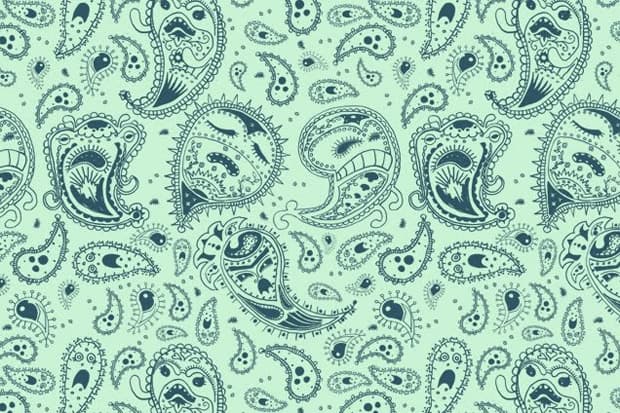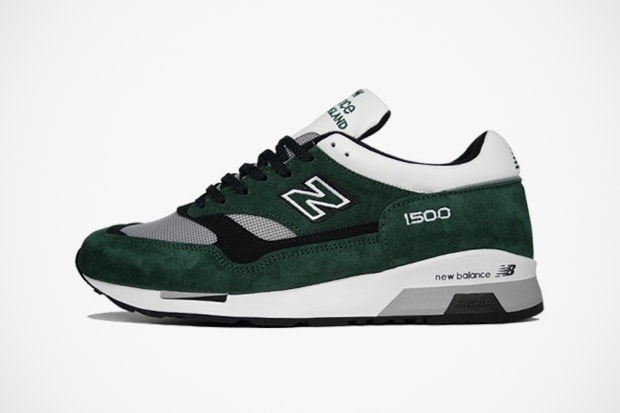Materials & Patterns: Paisley
You’ve probably seen it on bandanas worn by rough-and-tumble motorcycle riders or in small fabric

You’ve probably seen it on bandanas worn by rough-and-tumble motorcycle riders or in small fabric swatches sewn into the seats of worn-out jeans. Or on luxurious silk scarves at music festivals. Maybe you’ve seen it lining the sleeves of disco-era sportcoats at a local thrift shop. Paisley has certainly seen a heavily varied range of application on its journey through fashion history, some of which less befitting than others. Still, with these certain stigmata hurdles to overcome in the world of fashion, paisley is seemingly enjoying a certain resurgence in popularity in some high fashion circles.
Like plaid, argyle, or tweed, paisley is a historically rich design, and one whose origin differs from its European nomenclature. It’s also one of the most distinctive and easily recognized patterns in modern fashion. But unlike the aforementioned, paisley has not always enjoyed the same social status. This is due in part to its difficulty coordinating with traditional mediums, and oftentimes has been left relegated to outspoken fashion statements made in the wrong tone. But like any good heritage fabric story, the story of paisley pre-dates its modern stereotypes and applications by several full centuries, going as far back as the late sixteenth and seventeenth centuries. But to examine the life and times of the modern pattern, we have to dig deeper into its origins going as far back as the very roots of the design itself. The distinctive “twisted teardrop,” or mango-shaped design at the centerpiece of any paisley pattern is believed to be Indian or Iranian in origin — the latter of which has been known to have been using the design since the Sassanid Dynasty, which ended in 651 AD. Scholars agree that the pattern has long since been associated with Hinduism, but as for what it was inspired by, is still something of a mystery. The most widely accepted theory is that the pattern (then known as “Boteh”) as a whole is a stylized floral or botanical motif mixed with the outline of a cypress tree — commonplace in the Middle East, and widely recognized as a symbol of life and eternity. The Boteh was used not only in textiles, but also in jewelry, art, landscaping, and architecture. Its prevalence spread across the Middle East to other southern and central Asian nations, further muddling its own exact origins. It wasn’t until around the 1600s when British traders and spice merchants hailing from the East India Company brought the Boteh back to their own native countries, where it enjoyed very popular Western demand (due in part to beliefs that the pattern was an Asian charm used to ward off demons) — so much so, that traders were often unable to import enough to meet demand. It was that outpaced demand that prompted first French, then Scottish weavers to copy the pattern and produce the fabric on their own native looms. In the early 1800s, the first town to devote its output exclusively to the production of boteh-inspired patterns, was the Scottish town of Paisley, who used Jacquard looms to produce designs in a broad spectrum of colors and patterns that no longer needed to rely on originals for copying. The name stuck.
Paisley remained in the European public conscience for a number of years, but didn’t really take on global, or mainstream recognition until the late 1960s and early 70s, when it found its way on to the ‘hippy’ culture center stage during the Summer of Love. This was largely in part to the Beatles who returned from a trip to India, bringing with them a renowned interest in Middle Eastern spirituality, culture, and of course the psychedelic stylings of paisley. This quickly associated the pattern with certain social stereotypes that have remained with it to this day.
While often overt, the most effective and tasteful modern applications of paisley have always been in moderation. Small accessorial, accenting pieces like scarves, shawls, bandanas, bow ties, or even jacket linings, have served paisley well. What hasn’t best served the pattern, were its associations with violent gangs of the 1980s and 90’s who used red or blue colored paisley bandanas to signify their respective affiliations. But while many of the whimsical stereotypes still remain, much of paisley’s tasteful resurgence is due in part to high fashion designers like Alexander McQueen who use paisley’s youthful, and slightly edgy predispositions to appeal to a more casual audience. Japanese labels like madHECTIC have also taken a liking to paisley, using it as a subtle accenting pattern like on this cap, or going all-out like COMME des GARCONS did here with these casual sneakers. However, streetwear’s best interpretation was arguably The Hundreds’ extremely well-received Paisley Hoodie dating back more than half a decade ago.
A little paisley adds a touch of flair and unique taste when done properly, and it certainly belongs in every wardrobe. However, if we learned anything from the Summer of Love, it’s that “a little always goes a long way.”












